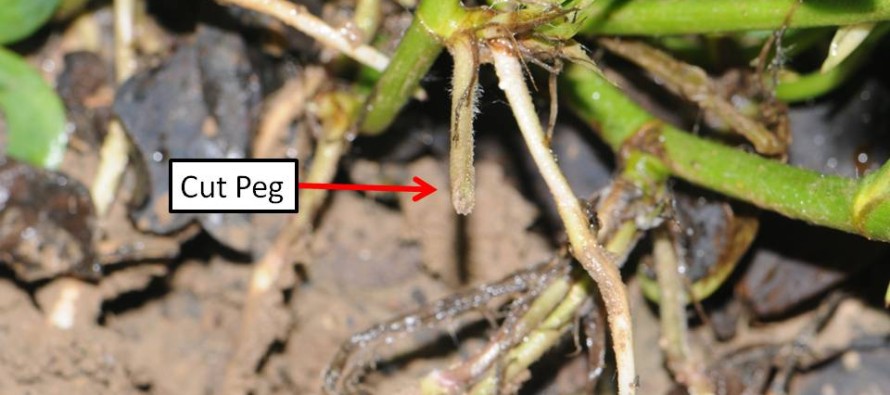Worms in Peanuts

I am getting a lot of calls about various worms in peanuts. In nearly every case, it is a complex of multiple species. It seems that the complex in the Delta region consists mainly of the rednecked peanut worm, granulate cutworm, and corn earworm/tobacco budworm. In most cases in the Delta, the renecked peanut worm is the most numerous of these three. There are a lot of questions about when to spray and how much defoliation can be sustained before yield losses are observed, so I will go through each species individually and then talk about the complex as a whole at the end.
Rednecked Peanut Worm
The most common calls the last week or so have been about rednecked peanut worm. This is a small pale colored worm with a black head. It is about 1/4 inch long when fully grown. The name comes from the fact that it has a red ring around it’s body behind the head. They feed in the terminals of developing peanut plants on young leaves that are still folded up in the terminal. Damage from this insect is mostly cosmetic and it takes a lot of them to cause even a small amount of yield loss (if any). The damage from rednecked peanut worm can look severe because they are feeding in the terminals of the plants, but the leaves will emerge from the terminal (as shown in the picture below) and although there is some feeding damage, the level of defoliation is fairly minor when the whole plant is considered. This species is fairly easy to control with most of the insecticides labeled.
Corn Earworm/Tobacco Budworm
Corn earworms seem to be the least common species of the complex currently being found in peanuts in Mississippi. Earworms and budworms are primarily foliage feeders in peanuts, but they can occassionally feed on pegs as well. Our current threshold is 8 per row foot and I feel pretty comfortable with this threshold because peanuts can withstand high levels of defoliation throughout the year without a significant reduction in yield. To sample for earworms and budworms, beat the plants against the ground in about 3 row feet, fold the plants back and count the number larvae on the ground. When the complex is primarily these species, the best levels of control are usually achieved with the larvicides listed in the Insect Control Guide (ie Steward, Tracer, Belt, etc.). The pyrethroids may not always provide acceptable levels of control of corn earworms and tobacco budworms.
Granulate Cutworms (and some may be Dingy Cutworm)
Granulate cutworm is the species that I am most worried about in this complex for a couple of reasons. First, they are very difficult to get an accurate count on how many are actually in the field. Cutworms feed at night and usually burrow into the ground during the day. So, if you are sampling during the day, you may count 3-4 per row ft, and actually have many more. Also, the counts you make on a cloudy day will likely be a lot higher than counts on a hot sunny day when it is bright. On bright sunny days, more of them will burrow into the ground.
The other thing that concerns me about cutworms is that they will cut pegs; and therefore, may cause direct yield losses in peanuts. The threshold for cutworms is the same as it is for most other catterpilars (8 per row ft). However, because of the reasons mentioned above, I am much less confident in the threshold for cutworms. Sample for cutworms the same way you sample for corn earworms. If you are finding a few cutworms, you can look at the pegs on the plants you fold back and see if any of them have been cut. If you are starting to see cutting on the pegs, I would be much more inclined to lower the threshold and make an application.
In terms of control, the most common species will most likely be granulate cutworms. Dingy cutworms look very similar and the two are difficult to tell apart in the field, so a few of them that you observe may be dingy cutworms. Both of these cutworms are difficult to control with pyrethroids, and like corn earworm, the best option for control is one of the larvicides listed in the control guide.
Conclusion
Before making a mangement decision, look at the complex as a whole and decide which is the most prevalent and most damaging species before choosing an insecticide. In general, little consideration should be given to rednecked peanut worms, because their feeding is going to mostly be cosmetic. Granulate cutworm has the potential to cause the most damage and they should weigh the heaviest on management decisions. Also, when spraying peanuts for insects this time of year, ground applications are by far the most effective and applications should be made at a MINIMUM of 20 GPA to penetrate the dense peanut foliage.











Let me tell You a sad story ! There are no comments yet, but You can be first one to comment this article.
Write a comment